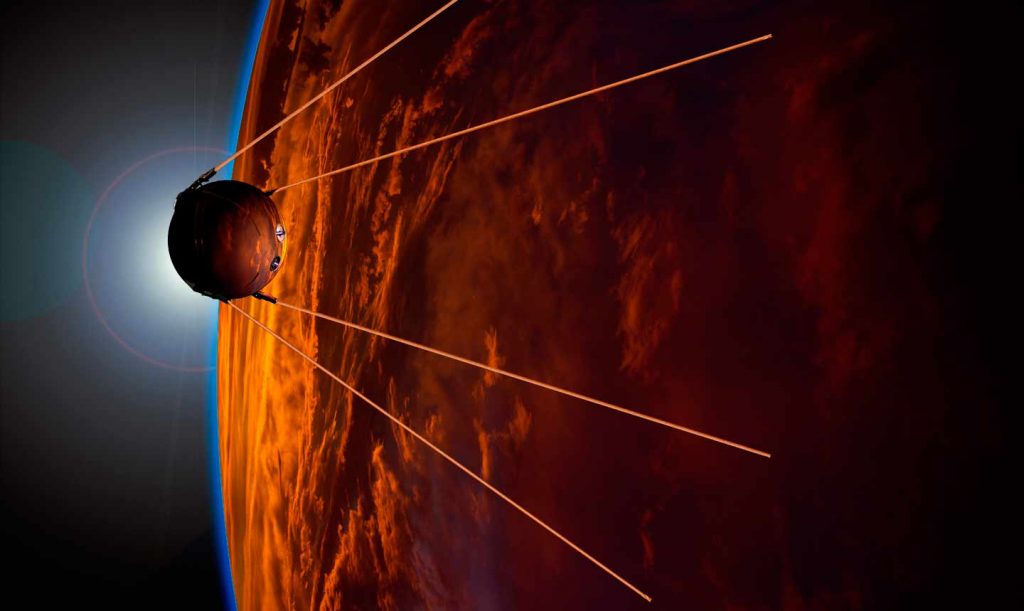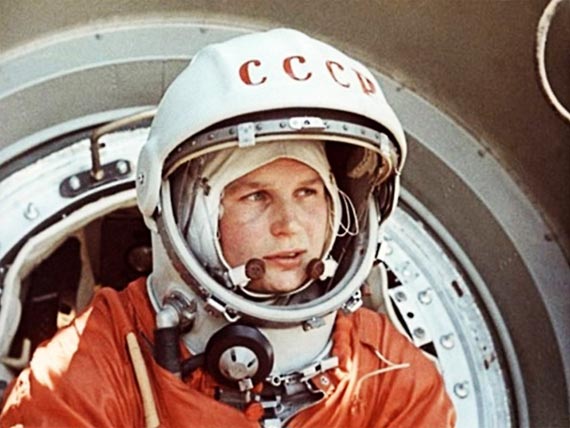The arrival of the first man on the moon on July 20, 1969 ended the space race, shifting the final balance in favor of the United States. But the truth is that most of the previous landmarks had first been reached by the Soviet Union, which led the way until the final triumph of its rival. We review here the main achievements of the Soviet space program before the historic Apollo 11 mission.
Sputnik 1, the first artificial object in the Earth’s orbit
The victory of the allied army in the Second World War prevented Nazi Germany from completing the development of the first intercontinental ballistic missile. With the sharing of the guardianship of the Third Reich between the victorious powers, German scientists and engineers began to provide services to the two big blocks, the USA and the USSR. Both countries were planning not only to manufacture long-range military rockets, but also to create the first artificial satellites.
The USA was believed to be leading the way in this technological progress when in July 1956 it announced its intention to launch the first device into the Earth’s orbit. On October 4, 1957, when the Soviet Sputnik 1 became the first man-made object successfully placed into orbit, the news was a surprise for the world and a blow to the administration of Dwight Eisenhower, especially when two months earlier the USSR had tested the first intercontinental missile.

With its 83.5-kilogram weight and 58-centimeter diameter, Sputnik 1, –whose name simply means “satellite”– surpassed everything tried by the USA in their failed attempts. The metal sphere that so astonished and terrified the West remained in orbit until January 4, 1958, when it burned up during re-entry into the atmosphere after completing 1,440 orbits of the Earth. During the first three weeks, the length of time that its batteries lasted, the beep-beep of Sputnik was captured by radio enthusiasts around the world; it was the first sound ever received from space by humans.
Laika, the first living being in orbit
The international impact of the success of Sputnik 1 spurred the Soviet leader Nikita Khrushchev on to achieve a new public relations coup, taking advantage of the 40th anniversary of the Russian revolution. On November 3, 1957, Sputnik 2 lifted off, assembled in less than a month and equipped with instruments to measure cosmic rays and solar radiation in the form of X-rays and ultraviolet rays. But the most memorable part of the satellite’s cargo was its passenger, the dog Laika. Previously, Soviet engineers had already launched dogs into space in suborbital rockets; Laika was the first animal to go into orbit.
Laika was a stray female dog collected in Moscow. For its trip, Soviet scientists attached biometric sensors to its body to measure its vital signs in order to obtain the first data on the physiological effects of space travel. From the beginning Laika was destined to be sacrificed, since the mission did not include the return to Earth. The dog’s conditions during the flight —chained inside a tiny space, with wires implanted under its skin and food and water for only one week— would be unacceptable today.
During takeoff, the animal’s heart rate tripled and its respiration increased fourfold. At the time, Soviet authorities were initially quick to report that Laika was fine after liftoff, but subsequent news arrived with less diligence and some serious contradictions. In 2002, one of the leaders of the mission revealed that Laika probably succumbed to the unbearable heat after the third or fourth orbit, within a few hours of the launch. Sputnik 2, with the remains of the dog, burned up on re-entry into the atmosphere on April 14, 1958.
Yuri Gagarin, first human in space
In the late 1950s the space race was in full swing, with the Soviet Union always one step ahead of its competitor: in 1959 the USSR had crashed the first artificial object into the moon, the Luna 2 probe, and the following year it had managed to recover the dogs Belka and Strelka from Earth orbit safe and sound. It was time to launch a man into space.
Chosen for the glory was Senior Lieutenant Yuri Alekseyevich Gagarin (9 March 1934 – 27 March 1968), one of the Air Force’s so-called Vanguard Six, the elite of the new cosmonaut corps. In Gagarin’s favor were his personal qualities and his experience, but also his height of 1.57 meters, ideal for the small cabin of the Vostok 1 (East 1) spacecraft. The first man in space lifted off on April 12, 1961 and barely managed to complete one orbit of the Earth on a mission of 106 minutes.
Luck was on Gagarin’s side; the unmanned tests of the Vostok had shown several failures, and an error in cutting one of the engines led to a higher than planned orbit. The pilot did not touch a single control during the flight; the mission was entirely controlled by automatic systems and from the ground. The re-entry was complicated by a problem with the engine brake and, after the ejection of the capsule, Gagarin landed by parachute 300 kilometers from his intended destination (which was near the launch site in Bainokur). Gagarin appeared in a Russian village wearing his orange space suit, and the farmer and his daughter who first spotted him were about to flee in terror at the strange apparition that had fallen from the sky.
Valentina Tereshkova, first woman cosmonaut
On June 16, 1963, two years after Gagarin’s feat, the Earth’s orbit received the first woman. Valentina Vladimirovna Tereshkova became the eleventh human being to cross the frontier of space and the first civilian, selected from hundreds of applicants. Originally a textile worker and amateur parachutist, Tereshkova was incorporated into the Air Force only to receive the necessary clearance for the flight.

Valentina Tereshkova’s spacecraft, Vostok 6, lifted off while the fifth of the Vostok missions, manned by Valery Bykovsky, was still in orbit. The USSR had already previously had two missions in orbit at the same time, Vostok 3 and 4. The purpose of these simultaneous missions was to make a show of strength against their US rival, but also to practice the future rendezvousing of spacecraft in space.
Bykovsky lifted off two days before Tereshkova in a launch plagued by mechanical failures. By contrast, the flight of the first female cosmonaut took place without major problems, although Chaika (Seagull), which was her call sign, felt physical discomfort during most of the mission and ended up vomiting. Both Vostok spacecraft approached each other in orbit to within just five kilometers, and they both returned to Earth with their crews on June 19. Tereshkova’s spacecraft was the last of the Vostok, which was to be succeeded by the Voskhod. No woman would again man a space mission until 19 years later. On August 19, 1982 the Soviet Svetlana Savitskaya became the first woman to fly aboard a space station, and she was also the first woman to perform a spacewalk (July 25, 1984).
Alexei Leonov, first spacewalk
The success in 1964 of the first Voskhod (Dawn) mission with three cosmonauts on board cleared the way for the next challenge for the Soviet program, the first spacewalk. On March 18, 1965, Alexei Leonov, one of the two crewmembers of the Voskhod 2, abandoned his spacecraft for 12 minutes with only his spacesuit for protection. The capsule made a total of 16 trips around the Earth in over 24 hours.
But once again the mission was not without its problems. During his walk, Leonov’s suit swelled up so much that he could not bend his joints, and he barely managed to get back through the hatch when re-entering the spacecraft. With their suits inflated the two cosmonauts could not sit down, which unbalanced the craft on re-entry.
Unlike the Vostok missions in which the crewmembers were ejected from the craft to land by parachute, the Voskhod touched down with its occupants inside. The capsule landed in a thick forest in the Ural Mountains, so frozen and remote that Leonov and his colleague, Pavel Belyayev, had to wait for a rescue party made up of skiers.
Comments on this publication